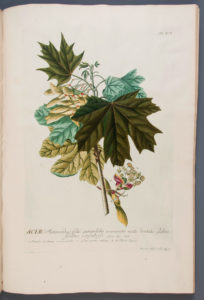
Wishing you and yours a happy Canada Day (July 1)…
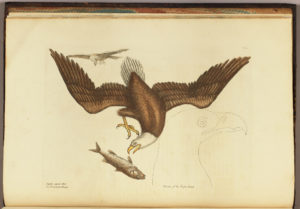
…and a festive Fourth of July!

Wishing you and yours a happy Canada Day (July 1)…

…and a festive Fourth of July!
by Julie Tanaka, Curator, Rare Books
This Wednesday, June 19, 2019, marks the 153 celebration of Juneteenth, the name African Americans in Texas gave to emancipation day.
On June 19, 1865, Major-General Gordon Granger, Union commander of the Department of Texas, arrived in Galveston, where he issued General Orders, No. 3:
The people of Texas are informed that, in accordance with a proclamation from the Executive of the United States, “all slaves are tree.” This involves an absolute equality of personal rights and rights of property between former masters and slaves, and the connection heretofore existing between them becomes that between employer and hired labor.
The freedmen are advised to remain quietly at their present homes, and work for wages. They are informed that they will not be allowed to collect at military posts, and that they will not be supported in idleness either there or elsewhere.
This order impacted approximately 250,000 slaves in Texas. Upon receipt of this news, newly freed slaves engaged in a variety of personal celebrations. In the following year, large public celebrations were held. These continue to today.
Juneteenth commemorates the emancipation of slaves in Texas and more generally those enslaved in the Confederate states. This day brings people together and is marked with picnics, family gatherings, parades, barbecues, and other events featuring guest speakers. But it is not merely a day of rejoicing and fun. Juneteenth also emphasizes education and reflection about achievements. It is a time of formal thanksgiving, often opened by the singing of “Lift Every Voice and Sing” written by James Weldon Johnson (1871-1938), the American writer and civil rights activist.
Despite the welcome news that General Gordon’s order brought to slaves in Galveston in 1865, the freedom proclaimed for these slaves arrived two-and-a-half years after President Abraham Lincoln had already granted them freedom He promulgated the Emancipation Proclamation on January 1, 1863:
That on the first day of January, in the year of our Lord one thousand eight hundred and sixty-three, all persons held as slaves within any State or designated part of a State, the people whereof shall then be in rebellion against the United States, shall be then, thenceforward, and forever free…
Though the Proclamation applied only to slaves in states that had seceded from the Union and that had not yet come under the control of the North, it marked a significant shift in the long process to end slavery in the US. This process culminated, at least on paper, two years later on December 6, 1865 when Congress ratified the Thirteenth Amendment to the Constitution of the United States.
 Three weeks after Lincoln’s promulgation, Harper’s Magazine published an unsigned article titled “Emancipation” on page 55 of the January 24, 1863 issue. In this article, the magazine announces that on the following two pages, it has published “another double-page drawing by Thomas Nast,” and offers its description of Nast’s work.
Three weeks after Lincoln’s promulgation, Harper’s Magazine published an unsigned article titled “Emancipation” on page 55 of the January 24, 1863 issue. In this article, the magazine announces that on the following two pages, it has published “another double-page drawing by Thomas Nast,” and offers its description of Nast’s work.
Lincoln’s action had attracted the attention of German immigrant and American editorial cartoonist, Thomas Nast (1840-1902). Nast allegorically rendered a freed African American family in the January 24, 1863 issue of Harper’s Weekly, which the magazine captioned “Emancipation of the Negroes, January, 1863—the Past and The Future. Drawn by Mr. Thomas Nast.” Nast attracts his viewer’s attention in the central roundel. Several generations of this family—all happy and stylishly dressed—a family not ripped apart by slavery.
In the surrounding images, Nast presents the past and the future. Scenes depicting the history of slavery—the public sale of slaves, families being torn apart, the brutality of slaves held in bondage—fill out the left half, while the rest of the image points toward the future and improved living conditions. The transition begins in the smaller roundel. Father Time holds Baby New Year, who unlocks the shackle of the slave kneeling before him. Columbia stands atop the central roundel. Below her to the left Lincoln’s portrait hangs on the wall next to the highly symbolic banjo (a symbol, rooted in African religious traditions, of slave life), and below Columbia to the right stands Justice before a scene of a Union victory. An American flag waves proudly above a public school with two children waving to their mom who wears a southern-style head scarf and holds an infant as they happily run off to school. Another sign of improved life in America are African Americans standing before a cashier’s window engaged in a business transaction.
Two years later, the large, Philadelphia print shop of King and Baird issued a commemorative print based on Nast’s image. The main difference between the 1863 image and the reissue is found in the small roundel. Lincoln’s portrait replaces Father Time, Baby New Year, and the kneeling slave. Whether Thomas Nast had approved this change or the issuing of the commemorative print is uncertain, but his message remains clear: the ills of America’s past can be corrected and as the US moves forward, new opportunities await for these emancipated Americans.
Texas State Libraries and Archives Commission, “Juneteenth.”
Texas State Historical Association, “Juneteenth.”
Fiona Deans Halloran, Thomas Nast: The Father of Modern Political Cartoons (Chapel Hill, University of North Carolina Press, 2012).
by Rachel Bohlmann, American History Librarian
Memorializing the Confederate States of America has been part of a national debate recently, as communities argue over public monuments that valorize a government and its soldiers who fought for slavery. This print, The Charge of the First Maryland Regiment at the Death of Ashby, was published in 1867, just two years after the end of the Civil War. It was an opening salvo in this debate.
Designed to be hung in the homes of Marylanders who identified with the Confederacy, it was commissioned to raise funds to erect a monument to the Maryland Line, a regiment of Marylanders who fought for the Confederacy. The monument was never built.
Although a slave state, Maryland remained in the Union during the war. After President Lincoln ensured that the legislature voted against secession in the spring of 1861, as many as 30,000 Maryland men fled to Virginia to enlist in the Confederate army. They made up about a third of all Marylanders (black and white) who fought in the Civil War. So many Marylanders joined the Army of Northern Virginia that they formed their own regiment, the Maryland Line. The print commemorated a victory of some of those Maryland Confederates near Harrisonburg, Virginia on June 6, 1862. Confederate troops, commanded by Stonewall Jackson, had engaged with Fremont’s Union forces north of Harrisonburg and were in retreat. Confederate Brigadier General Turner Ashby, in an effort to protect the rear of the retreating army, ambushed a detachment of Union soldiers with Maryland and Virginia troops. When the Union line was reinforced, Ashby was killed as he attempted to charge the Union position. The Marylanders then successfully repelled the Union attack and captured its commanding officer.[1]
The print’s image foregrounded Maryland soldiers poised to charge, including a dying Confederate soldier passing the regimental colors to another, a stock scene of nineteenth-century sacrifice and heroism. Ashby’s death is barely discernable in the background. The former Confederates who purchased this print would have already been familiar with Ashby, who had been widely hailed in the South as a hero both before and after his death. As one historian put it, “Ashby represents an early prototype of the Lost Cause hero.”[2] Even small and marginalized, Ashby’s image evoked a set of myths that many whites used to rewrite Southern history into a racialized story of plantation prosperity, contented slaves, and white manly honor.
Maryland raised many monuments honoring the Confederate cause in the century and a half following the war. Two years ago Baltimore removed four Confederate statues from public spaces because they valorized slavery and a government that defended it. The Maryland Historical Trust’s Governor’s Commission on Maryland Military Monuments updated its inventory to reflect these changes in public memory and memorialization. At the same time, however, the Daughters of the Confederacy and other groups rededicated a monument to Ashby outside of Harrisonburg. The debates over history and memorialization continue.
[1] Donald C. Pfanz, Richard S. Ewell: A Soldier’s Life (Chapel Hill: UNC Press, 1998), 204-06.
[2] Peter S. Carmichael, “Turner Ashby’s Appeal,” Gary W. Gallagher, ed., Shenandoah Valley Campaign of 1862 (Chapel Hill: The University of North Carolina Press, 2003), p. 117, accessed May 22, 2019, ProQuest Ebook Central.
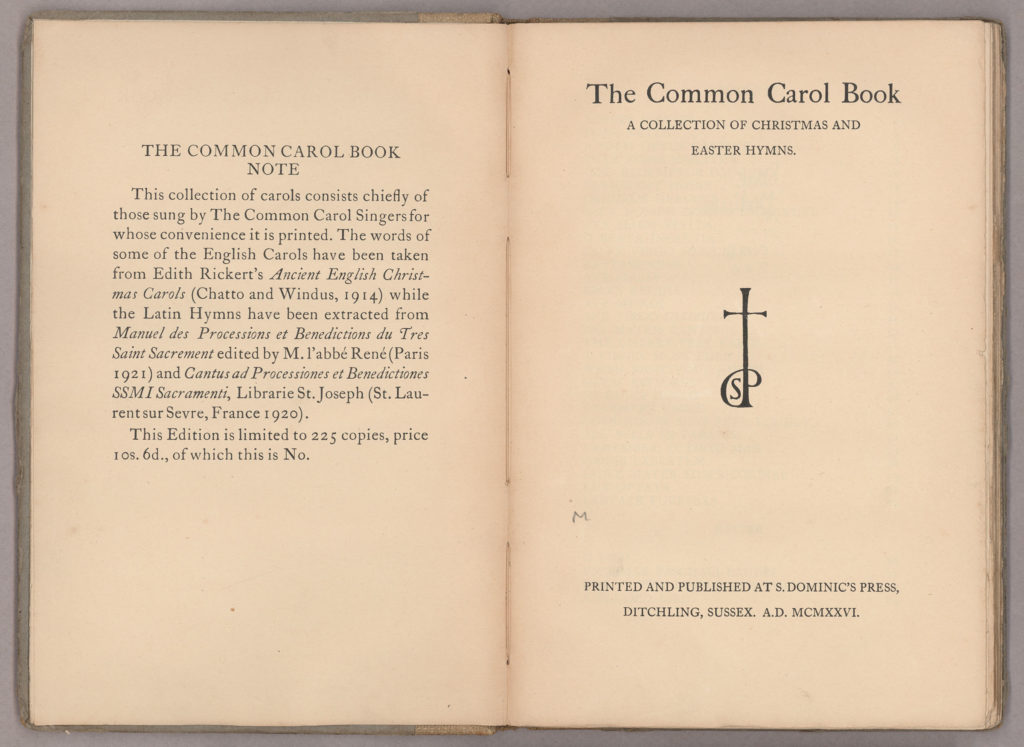
In honor of Easter, we are sharing images of the Easter hymns from The Common Carol Book: A Collection of Christmas and Easter Hymns (1926), a book printed by the Saint Dominic’s Press (SDP).
An exhibition which sets the story of the SDP within the larger history of the private press movement in England and examines its artistic as well as literary achievements is currently on display in Special Collections. The exhibition features different types of publications and posters produced by the SDP (though not this volume), is curated by Dennis Doordan (Professor Emeritus School of Architecture, University of Notre Dame), and runs through the summer.
by Aedín Ní Bhróithe Clements, Irish Studies Librarian
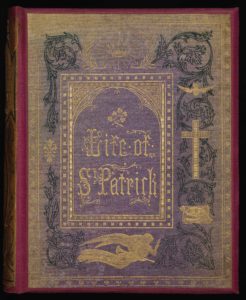 Visitors to the Special Collections usually notice our stained glass picture of Saint Patrick. However, this is far from the only reference to Ireland’s patron saint in the Special Collections. Among the many books, pamphlets and prints relating to Patrick, we have this Life of Saint Patrick, written by a woman known variously as the Nun of Kenmare, Margaret Anna Cusack, or Sister Mary Francis Cusack.
Visitors to the Special Collections usually notice our stained glass picture of Saint Patrick. However, this is far from the only reference to Ireland’s patron saint in the Special Collections. Among the many books, pamphlets and prints relating to Patrick, we have this Life of Saint Patrick, written by a woman known variously as the Nun of Kenmare, Margaret Anna Cusack, or Sister Mary Francis Cusack.
Sister Mary Francis Cusack, a prolific writer on Ireland and on the Catholic faith, was born in 1829. She grew up in County Dublin and also in England where she joined an Anglican religious order. In 1858 she converted to Catholicism and joined the Poor Clare order. [1]
In 1861, Cusack was among the founders of a new community of Poor Clares in Kenmare, County Kerry. In Kenmare, Cusack began to publish her writings, and became a well-known writer among Irish Catholics. Her writings found a market among Irish-American Catholics, contributed greatly to the convent’s income. She remained in Kenmare until 1880, and traveled to Knock, County Mayo, the site of an apparition in 1879. There she attempted to found a convent and industrial school. This endeavor failed, and she left for England.
In England, she established a new order, St. Joseph’s Sisters of Peace, with convents in Nottingham and Grimsby. She later moved to the United States and opened an American mother-house of the order, but this met with little success. Having had difficulty in her dealings with bishops, Cusack resigned from the order and left her convent. She left the Catholic Church and was a Methodist until her death in 1899.
The Life of Saint Patrick, Apostle of Ireland was written while she was Sister Mary Francis Cusack, published in 1871, and clearly intended for a wide readership as the title page lists publishers in London, Dublin, Boston and Australia. The first edition had apparently been published in Kenmare, County Kerry in 1869, with an American Catholic publishing house listed also on the title page. [2]
The saint’s life, as explained by Cusack, who argues that Patrick was a Catholic, and emphasizes his miracles, takes up the first 368 pages of this book and includes many illustrations. Each page is framed in a decorative border. In fact, the book would be a handsome addition to any home library.
‘The Tripartite Life of Saint Patrick, Apostle of Ireland’, pages 369 to 502 of this book, is, according to the title page of this section, translated from the original Irish by W. M. Hennessy.
While nowadays we expect a scholarly translation of old manuscripts to include introductory information outlining the sources used and the language of those sources, this information is difficult to glean from Hennessy’s translation. William Maunsel Hennessy (c. 1829-1899), was a highly-regarded scholar of Celtic studies and of Irish manuscript literature.
Hennessy’s text here is an edition translated from manuscript sources dating from about one thousand years earlier, and therefore in Old Irish, quite different from the language spoken in the nineteenth century. While Hennessy does not specify his sources, Cusack, in her introductory chapters, describes the various accounts of St. Patrick’s life found in the Book of Armagh, of which she states that the Tripartite Life is the most important. She also mentions that it is regrettable that the Book of Armagh is now in a Protestant institution, Trinity College, but on balance, it is a good thing that it is safe and well cared-for.
In Hennessy’s text, he occasionally alludes to his manuscript sources, for example, following the story of Patrick and his sisters being sold as slaves in Ireland, the author states that a leaf is missing from both the Bodleian and British Museum MSS. of the Tripartite Life.
The text describes many miracles carried out by Patrick, from boyhood on. The following passage describes the event where Patrick is said to have lit a fire in defiance of the king.
As the people of Tara were thus, they saw the consecrated Easter fire at a distance, which Patrick had lighted. It illuminated all Magh-Bregh. Then the king said, “That is a violation of my prohibition and law; and do you ascertain who did it.” “We see the fire,” said the druids, “and we know the night in which it is made. If it is not extinguished before morning,” added they, “it will never be extinguished. The man who lighted it will surpass the kings and princes, unless he is prevented.” When the king heard this thing, he was much infuriated. Then the king siad, “That is not how it shall be; but we will go,” said he, “until we slay the man who lighted the fire.”
…..
The druid Luchat Mael put a drop of poison into the goblet which was beside Patrick, that he might see what Patrick would do in regard to it. Patrick observed this act, and he blessed the goblet, and the ale adhered to it, and he turned the goblet upside-down afterwards, and the poison which the druid put into it fell out of it. Patrick blessed the goblet again, and the ale changed into its natural state. [3]
This Life of Saint Patrick calls out to be examined and researched. This lavishly-produced book invites questions about the readership and intended audience, the sources used, and many other questions. In fact, writing this blogpost was challenging because exploring the book raised more questions than answers. Where did the illustrations come from? Did W. M. Hennessy publish this translation anywhere else, and what were his manuscript sources? Who purchased copies of this book? As is the case with many of our books, a visit to the Rare Books and Special Collections to view this book up close would be very rewarding.
[1] Patrick Maume. “Cusack, Margaret Anna (‘The nun of Kenmare’)”. Dictionary of Irish Biography. James McGuire, James Quinn. (ed.) Cambridge, United Kingdom: Cambridge University Press, 2009.
[2] The 1869 edition may be viewed in Hathi Trust.
[3] Hennessy, M. F. ‘The Tripartite Life of Saint Patrick’, in Cusack, p. 385-388.
Rare Books and Special Collections is open through Friday, December 21, 2018. We will be closed for the Christmas and New Year’s Break December 24, 2018, through January 1, 2019. We will reopen on Wednesday, January 2, 2019.
by Julie Tanaka, Curator, Special Collections
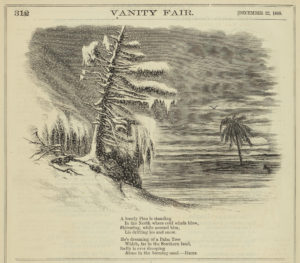 Vanity Fair, Saturday, Dec. 22, 1860—this was the first Christmas issue featuring a series of satirical columns and illustrations beginning with Richard Henry Stoddard’s account of poor, unemployed John Hardy thinking about “money, money, money” on Christmas Eve. Following this was some “Christmas Cheer” in England and a “Christmas Jingle.” Then Heine Heine’s lonely, shivering pine tree covered in snow dreaming about the palm tree in the warm southern lands. At center, a two-page spread of Virginia cavaliers celebrating the holiday.
Vanity Fair, Saturday, Dec. 22, 1860—this was the first Christmas issue featuring a series of satirical columns and illustrations beginning with Richard Henry Stoddard’s account of poor, unemployed John Hardy thinking about “money, money, money” on Christmas Eve. Following this was some “Christmas Cheer” in England and a “Christmas Jingle.” Then Heine Heine’s lonely, shivering pine tree covered in snow dreaming about the palm tree in the warm southern lands. At center, a two-page spread of Virginia cavaliers celebrating the holiday.
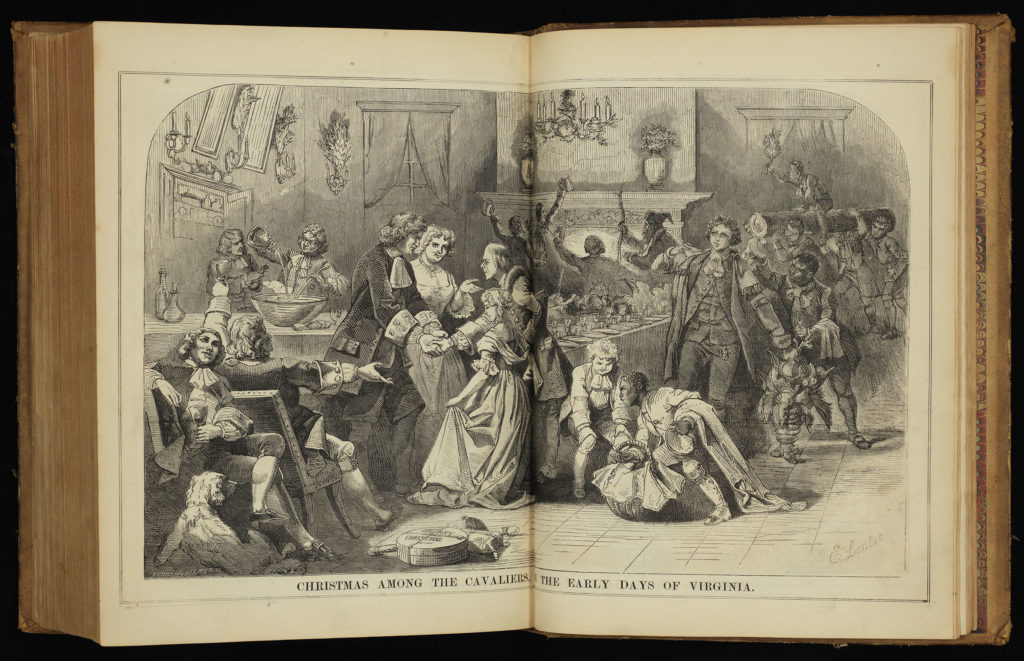
Vanity Fair was a popular title used for three subsequent magazines and should not be confused with the current one published by Condé Nast. The issue featured was from the American satirical magazine published by Louis Henry Stephens and edited by his brothers William Allen Stephens and Henry Louis Stephens. Vanity Fair was published with interruptions caused by problems obtaining paper on which to print between December 31, 1859 and July 4, 1863. Noted for its cartoons and satire columns, this magazine was critical of the Civil War’s progress and Abraham Lincoln’s policies.
Rare Books and Special Collections will be closed for Notre Dame’s Christmas and New Year’s Break (December 24, 2018, through January 1, 2019). We are open our regular hours during Exams, and welcome those looking for a quiet place to study.
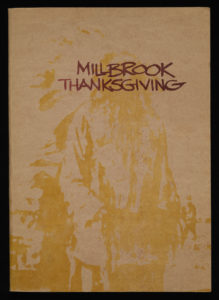 by Rachel Bohlmann, American History Librarian
by Rachel Bohlmann, American History Librarian
This Thanksgiving we’re highlighting a book of poetry and prose that is part of a group of avant-garde American literary works called the Small Press/Mimeograph Revolution, 1940-1970s collection. Millbrook Thanksgiving, by poet and writer Walter Schneider (1934-2015), is a panegyric to the psychedelic-fueled community Timothy Leary created in upstate Millbrook, New York from 1963 to 1967. A psychologist interested in the effects of synthetic drugs on human consciousness, Leary settled in Millbrook after being fired from Harvard University for using the substances he was studying (LSD was legal in the US at that time). In the wake of local police harassment that led to Leary’s repeated arrests for minor drug infractions, he moved to California where he crossed paths with Schneider, a PhD student at Berkeley.
Schneider’s spirited defense of Leary’s counter culturalism places the book’s content in the cultural vanguard of 1971. But so does the book’s production. Printed as a small run of just 3,000 copies, its design—from the soft cover, typography, and heavy paper, to its eclectic illustrations—signals the book’s origins outside of mainstream American publishing. Mad River Press, the small California-based operation that produced Millbrook Thanksgiving, specialized in experimental poetry and creations like Schneider’s. The press released very small runs of poetry chapbooks, which were short (40 pages or less), inexpensively constructed, soft-cover booklets. Some were published anonymously and with no identifying publication information, indicating that publisher and author rejected the authority of copyright law.
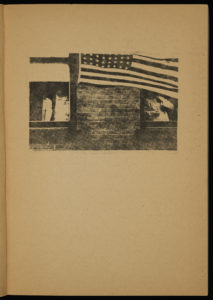 Mad River Press and its authors also placed important visual pieces in their publications. Millbrook Thanksgiving used the first photograph in Robert Frank’s The Americans (published 1958), an extended photo essay that captured Americans in real life. Beat writer Jack Kerouac, who introduced the 1959 edition, noted that “he [Frank] sucked a sad poem right out of America onto film.” His book of photographs remains an important visual text of post-war America. In a chapbook of poetry by Fred Glazer also published in 1971, Mad River Press included an image by the African American painter Louis Delsarte.
Mad River Press and its authors also placed important visual pieces in their publications. Millbrook Thanksgiving used the first photograph in Robert Frank’s The Americans (published 1958), an extended photo essay that captured Americans in real life. Beat writer Jack Kerouac, who introduced the 1959 edition, noted that “he [Frank] sucked a sad poem right out of America onto film.” His book of photographs remains an important visual text of post-war America. In a chapbook of poetry by Fred Glazer also published in 1971, Mad River Press included an image by the African American painter Louis Delsarte.
The library’s Small Press/Mimeograph Revolution, 1940-1970s collection holds more than 350 items. Some, like Millbrook Thanksgiving, were produced by small, experimental presses, while others were created by individuals or small collectives using relatively inexpensive copying technologies like the Ditto machine (remember the smell of those purple ink pages?) or the mimeograph. The collection is searchable in the library’s catalog.
RBSC will be closed during Notre Dame’s Thanksgiving Break (November 22-25, 2018). We wish you and yours a Happy Thanksgiving!
Thanksgiving 2015 RBSC post: Thanksgiving and football
Thanksgiving 2016 RBSC post: Thanksgiving Humor by Mark Twain
Thanksgiving 2017 RBSC post: Playing Indian, Playing White
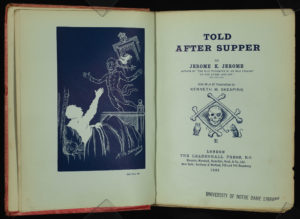 “It is always Christmas Eve, in a ghost story…”
“It is always Christmas Eve, in a ghost story…”
Told after Supper by Jerome K. Jerome is an anthology of short, humorous ghost stories. The copy in Special Collections, shown here, is the first edition, published 1891 by Leadenhall Press in London and illustrated “With 96 or 97 Illustrations” by Kenneth M. Skeaping.
The four primary stories, interspersed with shorter “Interludes,” are told by guests at a Christmas Eve dinner party hosted at the home of the narrator’s uncle. In 19th century England, it was typically not Halloween but Christmas Eve that was considered the time to tell spooky stories.
Jerome’s book follows in the tradition of Charles Dickens’ A Christmas Carol (first published in 1843) and other stories written or published by Dickens in the magazines he edited, Household Words and All the Year Round. Jerome’s stories are less frightening or moralizing, as the earlier Christmas ghosts tended to be, and more amusing.
And so, for this year’s Halloween post, we share for your amusement the first story from this volume, “Johnson and Emily; or, the Faithful Ghost”.
Happy Halloween to you and yours from all of us in Notre Dame’s Special Collections!
Halloween 2016 RBSC post: Ghosts in the Stacks
Halloween 2017 RBSC post: A spooky story for Halloween: The Goblin Spider
We join the Library of Congress and the National Endowment for the Humanities, National Gallery of Art, National Park Service, Smithsonian Institution, United States Holocaust Memorial Museum and U.S. National Archives and Records Administration in celebrating National Hispanic Heritage Month.
Also in recognition of the anniversary of Hurricane María and Puerto Rico’s ongoing recovery struggle, this post highlights the island’s artistic heritage.
by Erika Hosselkus, Curator, Latin American Collections
Puerto Rican artists Félix Rodríguez Báez, José A. Torres Martinó, Lorenzo Homar, and Rafael Tufiño (members of the Generation of ’50) formally established the Centro de Arte Puertorriqueño in 1950. This studio, art school, and gallery was influenced by the Taller de Gráfica Popular in Mexico and its mission of educating the public through art. At the same time, the member artists of the CAP used their work to express and assert a uniquely Puerto Rican identity.
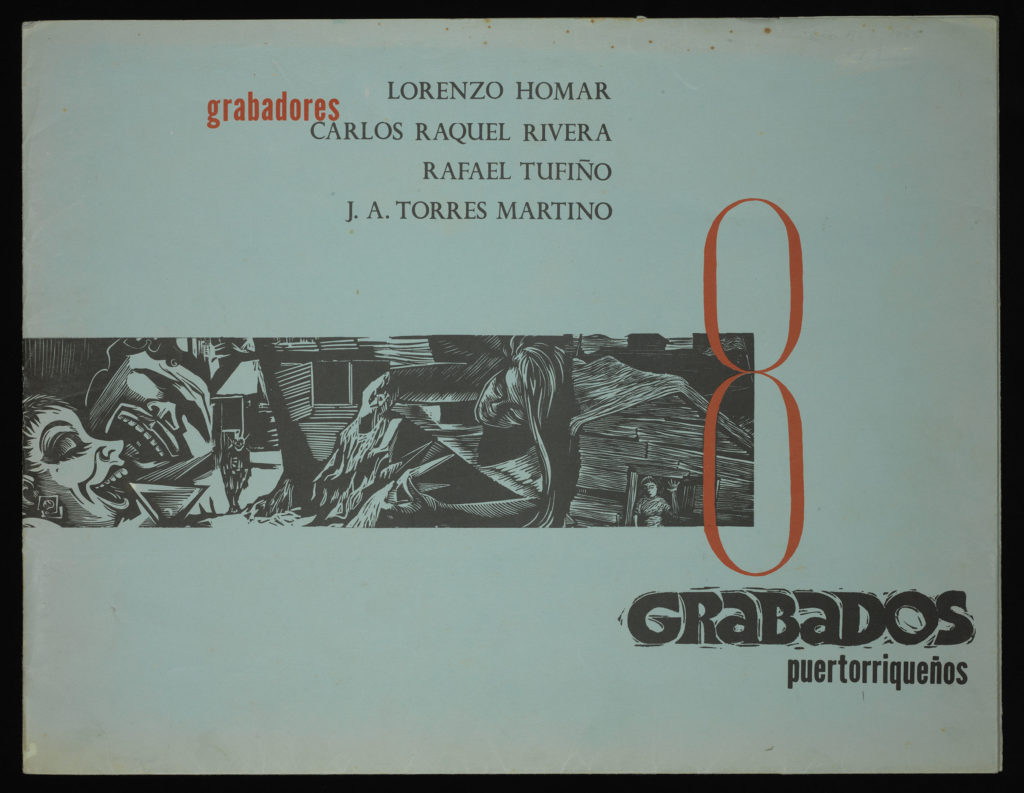
This portfolio of 8 prints, published in the late 1960s by the Centro de Artes Gráficas Nacionales, includes two works by each of four key members of the Generation of ’50, Lorenzo Homar, Carlos Raquel Rivera, Rafael Tufiño, and J.A. Torres Martino. The pieces are reproduced from original prints and were chosen to portray the development in aesthetic of each artist since 1951, when the CAP issued its first portfolio.
Carlos Raquel Rivera’s first print, “Marea Alta,” owes much to the influence of the Taller de Gráfica Popular in both the social commentary made through its content and in its style. His second print, “El Pegao,” reflects what had become Rivera’s signature style, driven by a strong black/white contrast.
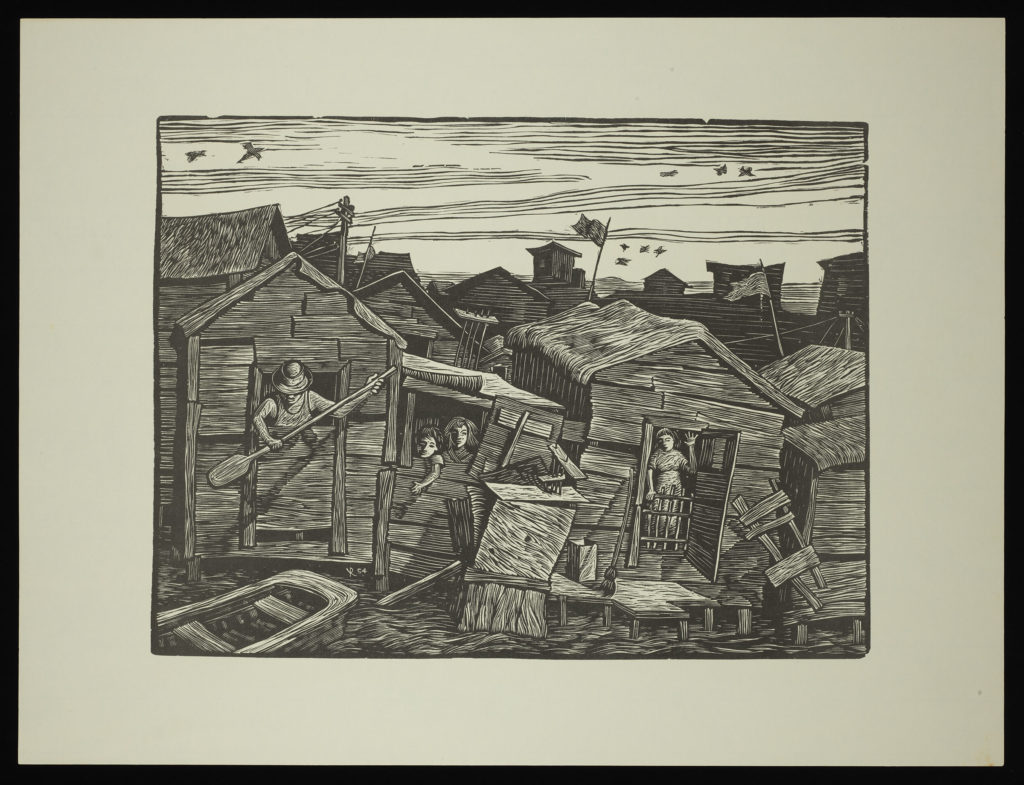
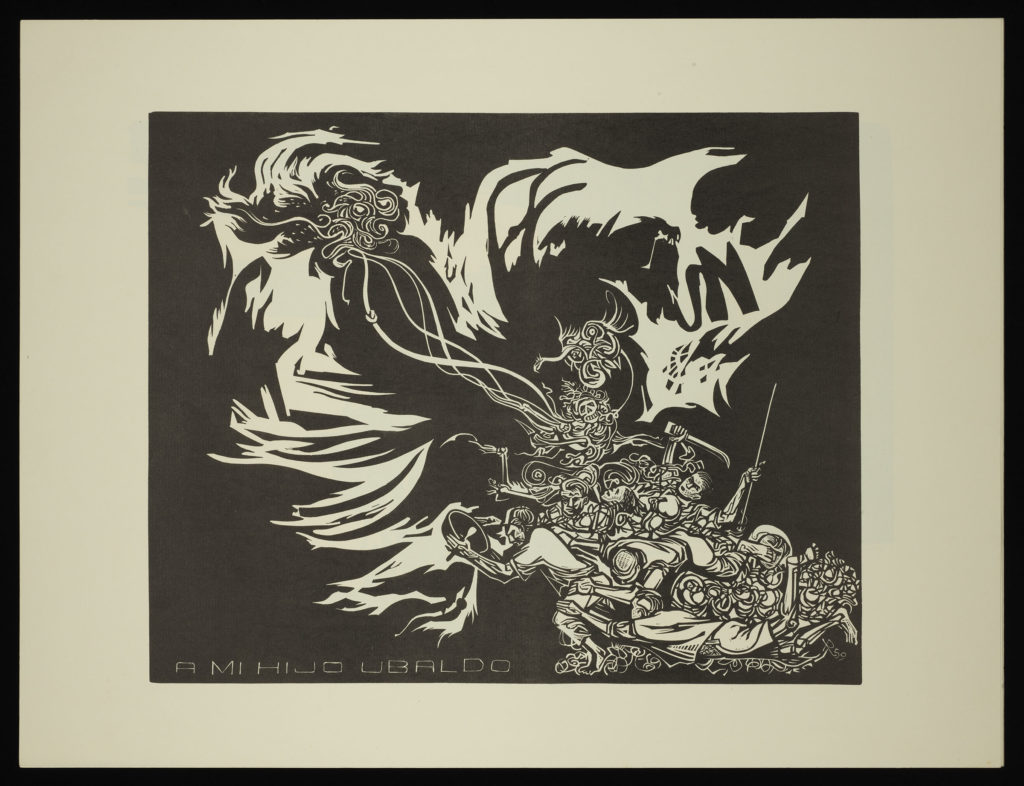
The contrast between the two prints submitted by Lorenzo Homar is striking also. “La Tormenta” a depiction of a man peering over his shoulder at an oncoming storm is poetic and suggestive while “La Vitrina,” a critical depiction of tourism in Puerto Rico is bold and aggressive in style.
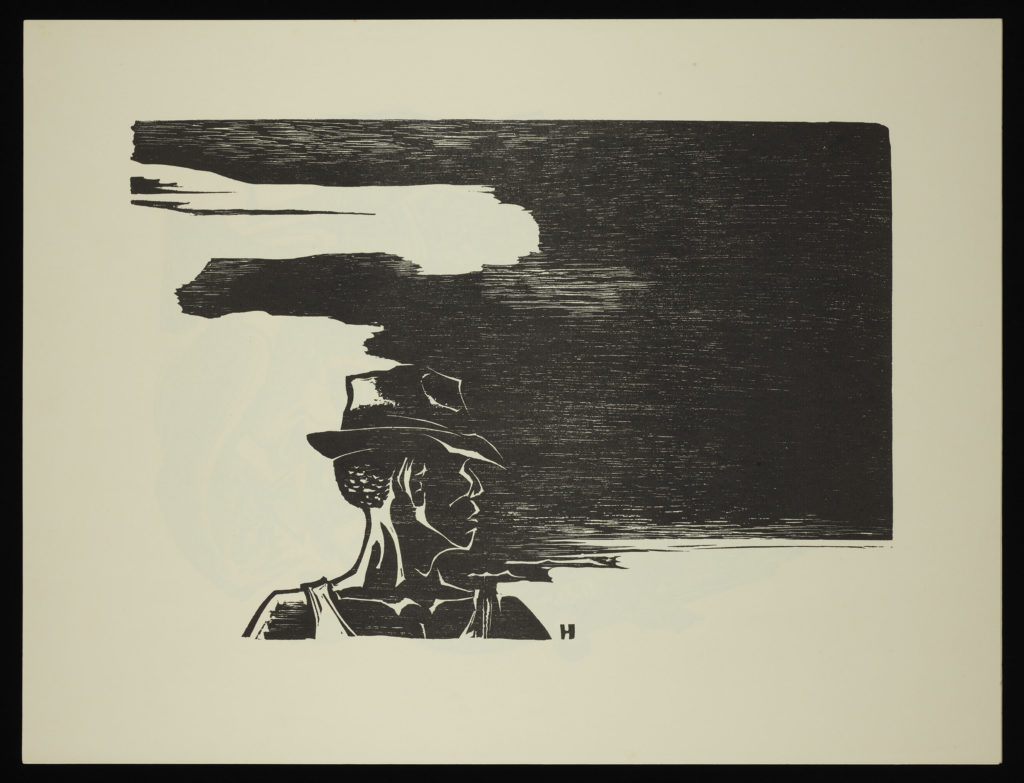
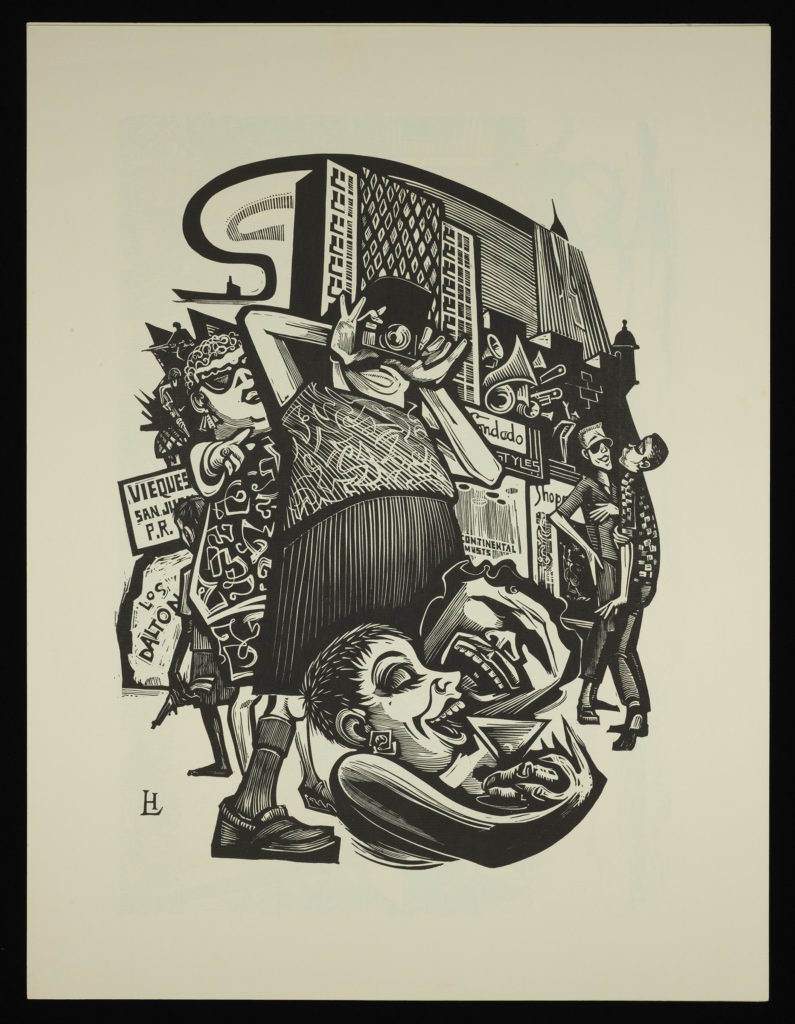
As a whole, this collection attests to the strength and evolution of print-making as an activist art form in mid-century Puerto Rico.